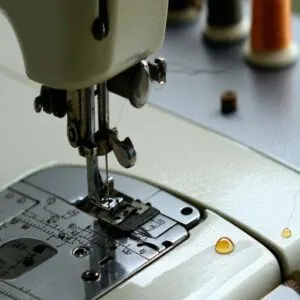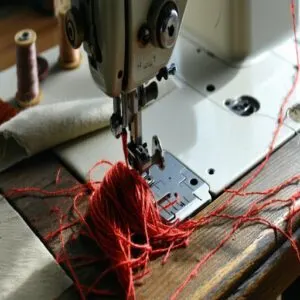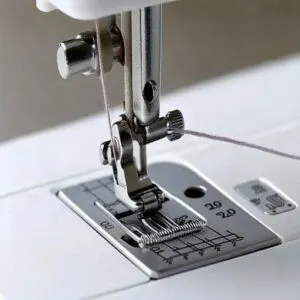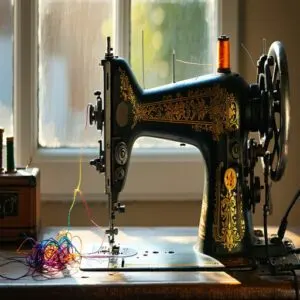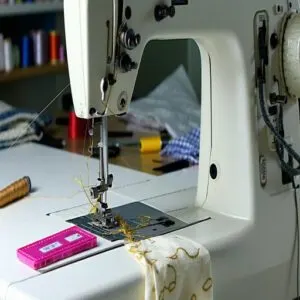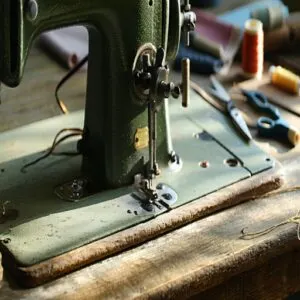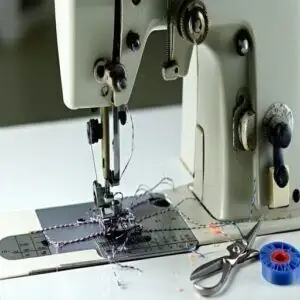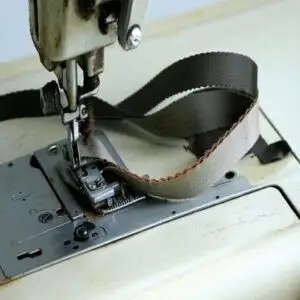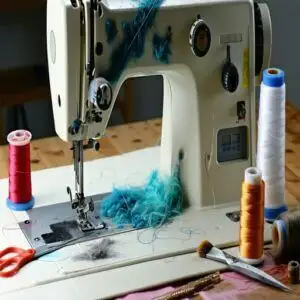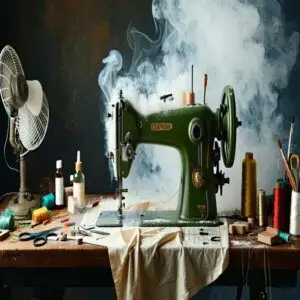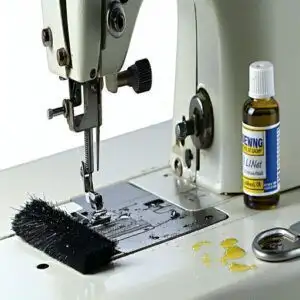This site is supported by our readers. We may earn a commission, at no cost to you, if you purchase through links.
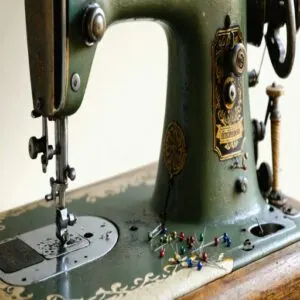 Sewing machine handwheel problems can really throw a wrench in your projects, but they’re often easy to sort out.
Sewing machine handwheel problems can really throw a wrench in your projects, but they’re often easy to sort out.
If the handwheel won’t turn, check for thread tangles or lint under the needle plate.
Clean it out and add a drop of sewing machine oil to keep things running smoothly.
Turning backwards? Double-check the bobbin size, threading, and lubricate the gears (just don’t drench them).
Forgetting to drop the pressure foot or improperly threading the hook can also cause hiccups.
Sometimes it’s a dull needle or even a heat-stressed motor.
Stay on top of maintenance, and your machine will hum along happily!
Table Of Contents
Key Takeaways
- Clean out thread tangles and lint regularly from the bobbin area and needle plate to prevent handwheel jams.
- Lubricate the handwheel and gears with sewing machine oil sparingly to keep them moving smoothly.
- Use the right bobbin size and properly thread your machine to avoid backward rotation or other issues.
- Replace dull or bent needles promptly and avoid overheating the machine to prevent handwheel stiffness.
Handwheel Won’t Turn
Got a handwheel that won’t turn? Don’t panic – it’s a common sewing machine hiccup, and you can fix it!
Start by checking for thread tangles or lint buildup. These sneaky culprits love hiding under the needle plate. Remove it, grab a small brush, and clean out the debris.
Still stuck? Lubrication issues might be to blame. Add a few drops of sewing machine oil to the handwheel and gears, then gently turn it.
No luck yet? The problem could be a bent needle or improper threading. Replace the needle and rethread your machine.
If the handwheel’s jammed because the motor is overheated, unplug the machine and give it a breather. Regular cleaning and oiling will keep your handwheel turning smoothly!
Handwheel Turns Backwards
If your sewing machine’s handwheel turns backwards, don’t panic—it’s a fixable glitch.
Reverse rotation usually means there’s a problem with lubrication or something’s snagged inside.
Grab sewing machine oil, add a few drops to the handwheel’s inner gears, then give it a spin to spread the magic.
Wipe off any extra oil so things don’t get messy.
For a detailed guide to troubleshooting handwheel problems, see this broken sewing machine hand wheel resource.
If it still acts up, check these common culprits:
- Wrong Bobbin Size: Using the wrong size bobbin can cause handwheel binding. Always double-check compatibility with your machine.
- Bent or Dull Needle: A damaged needle can jam the hook area, making the handwheel difficult to turn. Swap it out!
- Incorrect Threading: Misthreading can lead to backward movement. Re-thread carefully and follow your manual.
- Gear Problems: If troubleshooting doesn’t stop the reverse rotation, it’s time to call in a pro.
Don’t let a backward handwheel stop your creative flow!
Forgetting to Drop The Pressure Foot
Every now and then, you’ll hear that dreaded clunk when your machine stops dead – chances are, you’ve forgotten to drop the pressure foot.
It’s a common mistake that can lead to thread tension problems and messy fabric snags.
Your pressure foot’s job is to keep fabric flat against the feed dogs, ensuring smooth movement during sewing.
When the foot’s up, your fabric can’t move properly, causing thread jams and potential thread breakage.
For proper sewing machine alignment, always check your foot lifting techniques before starting.
A quick pressure foot adjustment makes all the difference between perfect stitches and a tangled mess.
Pro tip: Make it a habit to visually check your pressure foot position before hitting that pedal.
Think of it like buckling your seatbelt – a small step that prevents bigger problems down the road.
Forgetting to Thread The Hook
Those pesky thread jams and tension problems often start with one sneaky culprit – forgetting to thread your hook properly.
When you skip this vital step, your machine protests with skipped stitches and mysterious thread nests hiding underneath your fabric.
Let’s fix this together!
First, open your bobbin case and give it a quick cleaning – those lint bunnies love to hide here.
Next, place your bobbin in the case (direction matters!) and pull the thread through that special slot.
The secret sauce?
Make sure your thread follows the s-curve pattern in the hook area.
To avoid common issues, understanding bobbin thread problems that can affect your sewing machine’s performance is key.
Still having handwheel problems?
Double-check for any sneaky thread bits caught in the tension spring.
A clean bobbin case and proper hook threading are your best friends for smooth sewing.
Think of the hook as your machine’s heartbeat – when it’s happy, everything runs like clockwork.
Using Wrong Size Bobbins
Your machine’s happiness hangs on using the right bobbin size – it’s like picking the perfect puzzle piece for your sewing companion.
When bobbins don’t match your model, you’re asking for thread tension problems and frustrating jams that’ll stop your handwheel dead in its tracks.
For more troubleshooting tips, explore this guide on sewing machine bobbin problems.
Here’s what you need to know about bobbin compatibility:
- Most home machines work best with Class 15 plastic bobbins, while industrial models need metal Class M bobbins
- Thread weight should match your bobbin size – lightweight thread in oversized bobbins creates nasty nests underneath
- Check your machine’s manual or bring it to a dealer if you’re unsure about bobbin specs
The bobbin case is picky about size – even tiny variations can cause big headaches.
If you’ve got the wrong size, you’ll notice wonky stitches and thread jams right away.
Save yourself the trouble and stick to manufacturer-recommended bobbins – your machine will thank you with smooth, trouble-free sewing.
Forgetting to Replace The Needle
Neglecting needle replacement is like using a blunt pencil—frustrating and ineffective.
A worn-out needle can lead to skipped stitches, thread tangles, or worse, fabric damage.
Broken needles are even riskier, jamming your handwheel or scratching your machine.
Experts suggest switching needles every 8-10 hours of sewing or before a big project.
Using the wrong needle, like a regular needle on stretchy fabrics, may wreak havoc too—opt for ballpoint needles instead.
Here’s a quick reference:
| Needle Issue | Problem Caused | Solution | Frequency |
|---|---|---|---|
| Worn-out needle | Skipped stitches | Replace needle | Every 8-10 sewing hours |
| Broken needle | Thread tangles, jams | Immediate replacement | As needed |
| Wrong needle size | Fabric damage, jamming | Use fabric-appropriate needle | Start of each project |
| Old needle, bad type | Snags, skipped stitches | Check and replace often | Regularly |
Don’t forget—fresh needles keep your sewing smooth!
Time for a Tune-Up
When’s the last time you gave your sewing machine a little TLC? It’s probably begging for attention if it’s squeaking or acting up.
A regular maintenance routine is your machine’s best friend—and yours. Start with handwheel lubrication using sewing machine oil to keep things moving smoothly. Don’t forget the bobbin area and feed dogs, too, because that’s where lint loves to hide.
For more help, explore common bobbin problems and solutions.
While you’re at it, check for stretched belts causing slippage or strange noises. And those mysterious jams? They’re often caused by sneaky lint or thread tangles hiding in machine crevices. Cleaning fixes most of that!
DIY not cutting it? Book a professional tune-up to sort out deeper sewing machine handwheel problems. It saves you trouble down the line.
- Oiling moving parts prevents rust and squeaks.
- Cleaning lint buildup avoids future headaches.
- Replacing worn belts restores function.
- Machine inspections catch hidden issues early.
Causes of a Stuck Handwheel
A stuck handwheel can make you feel like your sewing machine’s got a grudge.
It’s usually caused by thread jams, lint buildup, a broken belt, or even your machine overheating after a long session.
Thread Jams
Dealing with a sewing machine handwheel stuck? It’s likely due to a jammed handwheel from loose threads.
Start by inspecting the hook area for thread obstructions. For persistent or complex jams, consider specialized sewing machine thread jam products.
- Check under the needle plate for tangled threads.
- Clean the bobbin case thoroughly to avoid issues.
- Examine the tension discs for knots or debris.
- Remove fabric snags caught in the mechanism.
- Use WD-40 sparingly to clear stubborn thread buildup.
Proper thread removal and regular bobbin cleaning prevent future jams. Master these steps to avoid sewing delays and keep your machine running smoothly!
Broken Belt
A broken belt is like a flat tire—it halts everything.
Regularly check for frayed edges or wear detection on the drive belt connecting the handwheel to the needle shaft.
If tension adjustment doesn’t help, it’s time for belt replacement.
Consider exploring various sewing machine belt products for replacements.
Lubricate the belt’s inner ridges and avoid lint buildup.
For stuck wheels or proper belt repair, call a pro before things unravel further.
Lint Buildup
If your handwheel’s jammed, lint buildup might be the culprit.
Dust and fibers sneak into the bobbin case, feed dogs, and tension discs.
A lint brush product page offers specialized tools for this task.
Grab a small brush or use compressed air for debris clearance.
Quality thread helps reduce fiber blockage, and oiling keeps lint from piling up.
Regular machine cleaning is key to hassle-free sewing.
Machine Overheating
When your sewing machine overheats, it’s like asking it to sprint a marathon—it needs a break.
Ignoring thermal limits can jam your handwheel.
To avoid problems, try these:
- Clean lint regularly and use sewing machine oil to reduce friction.
- Skip thick seams to protect the motor.
- Take cooling breaks during long sessions to protect motor and internal parts.
- Point a fan at the machine if it overheats, speeding up heat reduction.
With regular maintenance and these preventative steps, your machine stays cool under pressure!
Maintaining Your Handwheel
Ever noticed your sewing machine’s handwheel feeling sluggish or stuck?
It’s a sign it needs some TLC.
Regular cleaning and proper handwheel lubrication can keep things humming along smoothly.
Start by removing the needle plate to clear out lint and dust hiding in the nooks.
A soft brush or a quick blast of compressed air works wonders—just be gentle.
Next up, grab some sewing machine oil (the good, non-toxic kind) and apply a few drops to the handwheel shaft.
Think less is more—nobody wants an oil bath!
Use a flexible applicator for tricky spots, then run the machine briefly to spread the oil evenly.
These little preventive measures do more than just stop squeaks—they help your handwheel glide like butter and extend the machine’s life.
Add this to your maintenance schedule, and you’ll dodge more handwheel repair headaches down the road!
Frequently Asked Questions (FAQs)
Why is my sewing machine handwheel hard to turn?
Your handwheel might feel stuck because of thread tangles, lint buildup, or a lack of oil.
Check for debris, clean the bobbin area, and add sewing machine oil—don’t force it, or you’ll risk damage!
How to fix a sewing machine handwheel?
First, unplug your machine and remove debris or tangled threads around the bobbinn area.
Use sewing machine oil on moving parts, check thread tension, and turn the handwheel counterclockwise.
Still stuck? Call a professional.
What happens if a sewing machine handwheel is disengaged?
Imagine trying to steer a bike with the handlebars detached—it’s useless.
A disengaged handwheel means the needle won’t move, often because it’s set for bobbin winding.
Re-engage it, and you’re back in action.
What if a handwheel is stuck on a sewing machine?
When your handwheel’s stuck, don’t panic—it’s usually lint, thread jams, or a dry machine.
Unplug it, clean out debris, oil it up, and check the bobbin case.
Still stuck? Call a pro.
What is a sewing machine handwheel?
Did you know sewing machine handwheels drive the needle movement manually?
Located on the right side, they’re like a steering wheel for your stitches.
Turn it counterclockwise, and voilà—complete control over your sewing precision!
What causes a hard-to-turn sewing machine handwheel?
When your handwheel feels like it’s stuck in molasses, it’s likely lint buildup, thread jams, or poor lubrication.
Overheating, a misaligned bobbin case, or a broken belt can also throw a wrench in things.
Why won’t the handwheel on my sewing machine turn?
It’s like hitting a brick wall—your handwheel might be stuck due to thread jams, lint buildup, broken parts, or lack of oil.
Check the bobbin, clean debris, and try turning counterclockwise gently.
How do you fix a stiff hand wheel on a sewing machine?
Loosen up that stiff handwheel by clearing threads, lint, or debris first.
Lubricate the machine with sewing oil, turning the wheel gently counterclockwise.
Still stuck? Check the bobbin area or call in a pro.
Why is my sewing machine motor not spinning?
Imagine this scenario: you press the pedal, but nothing moves.
Check for a snapped belt, jammed threads, or motor burnout.
Sometimes, it’s just a loose plug or overheating – let it cool and try again!
Should the handwheel on the sewing machine always be turned?
You should only turn the handwheel counterclockwise when needed, like adjusting the needle position or clearing thread jams.
This action should be done with care, as spinning it backward or unnecessarily can mess up threading and cause annoying issues—stay gentle and deliberate!
Conclusion
Did you know that nearly 70% of sewing machine issues start with simple fixes?
Regarding sewing machine handwheel problems, a little maintenance goes a long way.
Keep your machine clean, clear out thread jams, and use the right-sized bobbins.
Don’t forget to oil it regularly and replace dull needles to avoid headaches.
By staying on top of these quick checks, your handwheel (and projects) will run like a dream.
Happy sewing!
- https://sewingmachinetalk.com/sewing-machine-handwheel-problems/
- https://sewingtrip.com/sewing-machine-handwheel-problems/
- https://sewingmachinebuffs.com/how-to-fix-sewing-machine-handwheel/
- https://help.brother-usa.com/app/answers/detail/a_id/65109/~/handwheel-does-not-turn-or-is-tight
- https://www.craftsy.com/sewing/article/sewing-thread-tension/

